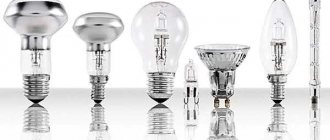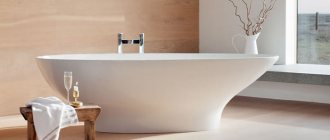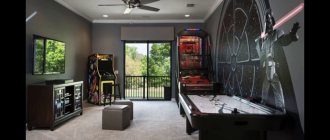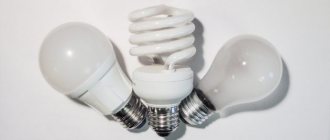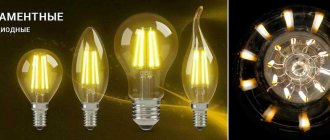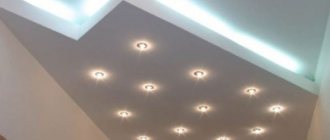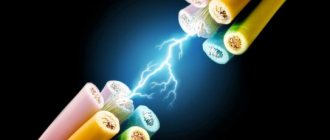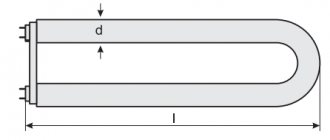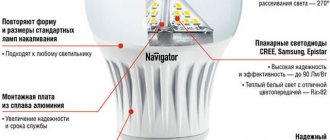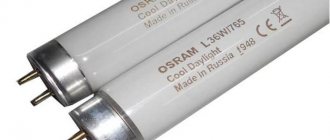Features of the device and design
The lamp contains an inert gas environment with mercury vapor. The inner surface is coated with phosphor, which is a luminescent substance. At the edges of the lamp there are tungsten spirals treated with barium oxide. The cathodes are connected to pins that provide connection to an external power supply.
For the lamp to work properly, it must be completely sealed. If oxygen penetrates into it, the chemical composition of the device will change and the lamp will lose its functionality.
The figure below shows the structure of a fluorescent lamp.
The following figure shows how a compact fluorescent lighting fixture is constructed.
Fluorescent light bulbs can only provide daylight. However, such lighting is quite bright, and therefore blinds the eyes. To make the light more comfortable, lamps are equipped with diffusers and reflectors. These devices help distribute light evenly throughout the room.
Areas of application
Based on the place of application, fluorescent light bulbs are usually divided into two types - industrial and household.
Industrial
They are used to organize lighting in enterprises. The lamps built into the spotlights are capable of illuminating large areas with high ceilings. For hazardous operating conditions (we are talking about enterprises in the chemical and alcohol industries), explosion-proof lamps are produced.
Household
To illuminate a residential building, as well as for offices, household modifications of fluorescent light bulbs are used. Fluorescent lamps are often used to illuminate offices, kitchens and corridors. There are special lamps designed for use in adverse conditions: they cope well with exposure to moisture and dust.
Types of structures
Based on design features, it is customary to distinguish the following types of lamps:
- Open ceiling products. To ensure safety, such lamps are sometimes equipped with protective grilles.
- Recessed lamps. Such light sources are mounted under the ceiling covering.
- Wall models. There are many modifications of such lamps. For example, the linear type of lamps has an elongated shape and is used to illuminate extended objects. Overhead models are installed using anchors fixed in the wall.
- Corner lamps. Such devices are mounted at the joints between the ceiling and walls. Externally, the design resembles a ceiling plinth. This type of lighting fixture is often chosen for kitchens.
- Hanging devices. Fixed to the ceiling structure using a cable. One wire carries from one to several light bulbs.
- Closed lamps. Used in combination with stretch ceilings. Such models do not overheat, which ensures the safety of the ceiling material.
- Furniture models. Fluorescent lamps are used to illuminate furniture. Fluorescent lighting not only performs a utilitarian function, but also serves as a decoration for furniture.
In recent years, the production of economical models of fluorescent lamps has been gaining momentum. The technology is based on the use of a special gas - phosphor. As a result of the interaction of gas and current, an ultraviolet glow is formed without heating the device.
Four-lamp lamps with a power of 4x18
Lamps with fluorescent lamps with a power of 4x18 are installed in rooms with high humidity, thanks to the presence of moisture-protective devices on them. 4x18 overhead structures are most suitable for use in offices, compared to 2x36 lamps, which provide mainly general lighting for public buildings. Fluorescent lamps are manufactured with a power of 18 and 36 W, in various colors, with a different number of lamps, depending on the power of two-lamp 2x36 or four-lamp 4x18 designs.
In lighting devices of the 4x18 type, electronic ballasts are usually used. Ceiling lighting fixtures of the 4x18 type with overhead mounts are installed in public buildings. Less often than 4x18 lamps, 2x18 lamps are used when it is necessary to illuminate a smaller area. The raster-type designs of Armstrong 4x18 lamps are mounted in suspended and recessed ways, providing a total lamp power of 72W. Thanks to mirror grilles, 4x18 overhead structures ensure uniform distribution of light throughout the room.
[custom_ads_shortcode1]
Advantages and disadvantages
The advantages of fluorescent light sources include the following characteristics:
- High brightness of light, which allows for excellent visibility. Fluorescent lighting is especially useful when performing small manipulations that require precise movements.
- Long service life. Compared to incandescent lamps, fluorescent lamps last longer.
- Various modifications of lamps. Products are produced that are suitable for any interior.
- The bulbs do not overheat, which has a beneficial effect not only on the service life of the light source, but also on the finishing materials located in the immediate vicinity (we are talking primarily about stretch ceilings).
- Saving energy consumption.
- Easy to clean the device from dirt or dust.
The disadvantages of fluorescent lamps include:
- Lack of DC power supply.
- Sensitivity to temperature conditions, which can reduce the light output of the device.
- Presence of mercury inside the lamp, which creates a dangerous situation if the bulb is broken.
Compact fluorescent lamps for supplementary lighting
What are these lighting sources, and how do they differ from classic ones? They are marked CFL - Compact Fluorescent Lamps. In some cases, installing a 60 cm long lamp is not always convenient, and compact samples perfectly solve the problem of lack of space. Such lamps are filled with a smaller amount of gas mixture. You can find them in specialized stores.
Compact grow lights have a shorter lifespan, which means they have to be replaced more often to achieve the desired effect. On average, the period of use of such a sample is approximately 1 year, then the effect decreases.
Important characteristics when choosing a lamp
When buying a lamp, you should take into account its technical capabilities:
- A significant advantage of the product is the possibility of a cold start. In such lamps, the electrodes heat up gradually, as a result of which the light turns on with a slight delay. A soft start significantly increases the working life of the lamp.
- It is recommended to take a closer look at the power ratio between the old incandescent lamp and the installed fluorescent lamp. The power of a fluorescent lamp of 12–15 W is enough to replace a 60-watt incandescent light bulb. However, despite the difference in power, the luminous flux characteristics of different types of lamps should be approximately the same.
- The color of the lamp is determined by the characteristics of the room. For an office or kitchen, cold light is preferable. This will increase your concentration on doing any work. In the bedroom, living room or dining room, warm color tones are more relevant. They do not irritate the organs of vision. For the bathroom or garage, you should choose devices that are protected from moisture and dust.
Advantages
- safety in use due to the use of protective structures;
- noiselessness, thanks to the use of electronic ballasts (EPG);
- the compactness of the lamps allows them to be widely used in lamps of any design;
- providing greater light output (up to 5 times) with the same power as incandescent lamps;
- service life increased by 8-12 times compared to incandescent designs;
- the ability to choose a convenient shade of the light produced;
- up to 30% energy savings.
[custom_ads_shortcode1]
Areas of application
Fluorescent light sources are used in many areas of human activity:
- In medicine. Fluorescent lamps are often used in medical offices. The quality of light allows doctors to carry out diagnostic measures more thoroughly.
- Luminescent devices are common in manufacturing. Features of the technology make it possible to cover large areas with high-quality concentrated lighting. Daylight is especially important when carrying out small precision operations (for example, when working on a lathe).
- In the kitchens of public catering establishments, as well as for cooking at home.
- In scientific institutions and laboratories.
- In libraries, in educational institutions.
- For organizing outdoor lighting. Fluorescent sources are used not only for lighting, but also as decorative light. Fluorescent lamps are often found on garage canopies and at building entrances.
- Office rooms.
- Trading establishments.
- Living spaces.
Interior use
Fluorescent light sources are used in a wide variety of interior solutions, but they are most appropriate in modern styles:
- High tech. This style uses long lamps mounted at the junctions of ceilings and walls. Such lamps emphasize the geometry of the room. For high-tech, cold tones are most often used.
- Minimalism. Fluorescent lamps are made of plastic and are massive flat structures.
- Ecological design. They are used in a frame of natural materials (wood or leather) and emit warm light.
- Premises in loft style. Such lamps in their design and placement must correspond to the general style of the room - a former industrial building converted into apartments.
- Eclecticism. Economy lamps placed in a line are used.
Note! Cold light is suitable for living spaces with windows facing south. Also, cold light dilutes the too warm tones of finishing materials.
Installation of fluorescent lamps
If desired, it is easy to install fluorescent lamps yourself. Installation of lighting devices is carried out based on their design features. The devices are mounted on ceiling structures, on walls, in columns, etc. For fixation, dowels and mortgages are used.
Ceiling sockets are installed to connect the luminaire wiring to the electrical network. They mask the hole from which the conductors come out.
For wall lamps, sockets are mounted at a short distance from the light source. A cord comes out of the housing and connects to the power source through a plug.
When installing a mechanical switch, special attention should be paid to the reliability of the contacts. Otherwise, during operation, the contact surfaces may shift, causing the lamp to stop working.
The connection diagram of the device is also important. Most often on the market there are modifications equipped with chokes and starters. Such devices have dedicated sockets. One of the capacitors is connected in parallel and acts as a voltage stabilizer. The second capacitor is designed to extend the pulse time at the start. This connection is called electromagnetic balance. Its diagram is shown in the figure below.
All fluorescent lamps have a diagram. It is shown on the back of the device. The diagram contains sufficient information about the number of light bulbs, their power, as well as other significant characteristics of the device.
Note! It is easy to convert a lamp with fluorescent lamps to work with LEDs. Before replacing the lamp, the ballast must be removed from the circuit. Light diodes must receive voltage directly.
The optimal way to place fluorescent devices is to hang them on the main line (lighting boxes like KL-1 or KL-2). Together with the boxes, all the necessary components for installing a fluorescent lamp are available for sale.
Important! Before connecting the lamp, you should insulate the ends of the wires.
How to install correctly
The use of lighting with fluorescent lamps and phytolamps will give a higher effect if the following rules are observed during their placement:
- Installing mirror reflective screens will create directed rays that illuminate only the plants. Such devices simultaneously protect the eyesight of people working with greenery.
- It is not advisable to place light sources on the side, since this resembles the approach of darkness and all processes in the leaves begin to slow down.
- The lamp should be as close to the plants as possible, while avoiding overheating and burns. The most optimal distance is considered to be 15-50 cm.
- The placement locations prevent moisture from entering the lamp, especially during watering.
- Different types of plants require individual lighting regimes for greenhouses and greenhouses.
When installing additional lighting, it is recommended to use compact fluorescent lamps with or without ballast. The ideal design includes several such products, which together give maximum effect. This option is not widely used due to the relatively high cost of compact lamps.
Fluorescent lighting should be turned on in the evening when there is insufficient natural light. Plants must receive light for 14 hours a day, that is, the missing time must be added to the daylight hours, which will be additional lighting. This regime is especially important for light-loving plants that require a lot of light. Phytolamps do not cause burns and are the best option for greenery.
Possible breakdowns
There are several common reasons why fluorescent devices malfunction:
- Triggering of the protective mechanism. This happens due to a short circuit in the electrical network (behind the machine) or a malfunction of the capacitor at the input. This problem is especially common when replacing fluorescent lamps with LED lamps. The problem is corrected by replacing the capacitor. The contacts of the cartridges and the starter should also be tested for working condition. Light bulbs may need to be replaced.
- The light doesn't turn on. The reason is insufficient voltage in the cartridge or its complete absence. The voltage is checked using an indicator screwdriver or a multitester. If the device does not turn on, but there is light at the ends of the tube, the starter is broken. In this case, the starter should be replaced. The absence of a glow indicates a malfunction of the throttle, starter or the lamp itself. If only one end lights up, there is an error in the circuit and needs to be double-checked.
- Continuous flickering. The problem occurs when the starter fails or when there is insufficient voltage in the electrical network. You also need to check the connection diagram - there is probably an error.
- Regular turning on and off of the light bulb indicates its failure. The lamp will need to be replaced.
Checking the lamp
First, check the proper operation of the lamp using a multimeter or tester. There are certain nuances in four-lamp and two-lamp lamps. For example, in an Armstrong lamp, electronic ballasts for 4 lamps, if one bulb fails, all four will not light. The same applies to devices with one starter for two tubes. In luminaires where each lamp has a dedicated starter, the luminaire will function without problems if other lamps fail.
If the power supply is connected, but the lamp does not turn on, check the voltage supply. This is done from the terminal block at the input.
The performance of fluorescent light sources is assessed by the integrity of their components that ensure current transport:
- The throttle should not make any sounds.
- The starter is checked by connecting it to an incandescent light bulb and a socket.
- Check the capacitance of the capacitor.
Diagnostics are carried out only with the device disconnected from the power supply. The optimal means for taking measurements is a multimeter or ohmmeter. To carry out the test, remove the starter from the cartridge and connect the contacts. The probes are brought to the terminals of the lamp wires. As a result, the device will display the total resistance of the lamp.
Advantages and disadvantages
Fluorescent lamps are characterized by a number of quite significant advantages, which determines their popularity:
- long service life, during which there is no need to change the lamp (10,000-20,000 hours), for comparison, analogs with an incandescent filament operate no more than 1,000 hours;
- low level of energy consumption, again, when compared with an analogue based on incandescent lamps (the difference is about 4 times);
- multivariate shapes of light sources (linear, compact), which determines the difference in the design of the lamp (square ceiling 4x18, linear wall type);
- different shade of light depending on what type of lamp is used;
- the ability to create diffuse lighting;
- high intensity of glow.
There are also disadvantages, and most of them significantly affect (negatively) the quality of life near such lamps:
- the presence of toxic substances in the light source (mercury vapor in the gaseous contents of the flask) in an amount of 2 to 5 mg; for comparison, a thermometer contains no more than 3 mg of this substance;
- the emission spectrum of the lamp in such lamps is unpleasant for the eyes;
- the possibility of flickering of lighting devices due to the fact that the operation of the light source used in them requires a ballast; a modern and more advanced electronic analogue of such an electromagnetic type device does not always solve the problem, since some manufacturers allow themselves to use capacitors of insufficient capacity.
Lamps with compact fluorescent lamps will be more expensive than, for example, more familiar designs with linear light sources (ceiling type 4x18). This is due to the fact that lamps with a standard E14, E27 socket can be used instead of analogues with an incandescent filament, and this is very convenient. In addition, in such versions an electronic ballast is used.
And, in addition, lamps created for compact fluorescent light sources are presented in a variety of shapes and style solutions.
[custom_ads_shortcode2]
Famous manufacturers
In order for a fluorescent lamp to work for a long time, it is recommended to study the proposals of manufacturing companies in advance. There are products from dozens of companies on the market. However, only a few brands have achieved an impeccable reputation:
- Philips. The products of the Dutch company are the standard of quality and technological excellence. The Philips assortment includes a wide variety of modifications of fluorescent lamps.
- Ares. The products of the Italian company are known all over the world. The company produces lamps not only for indoor lighting, but also for decorative lighting.
- "Thorn Lighting" (Austria). The company has established itself as a manufacturer of high-quality equipment for industrial and warehouse facilities. Also in the Thorn Lighting assortment there are fluorescent spotlights.
- Osram. The German manufacturer is one of the leaders in the global lighting equipment market.
Products from domestic companies are also on sale:
- offers economical lamps for residential and office premises, as well as for outdoor lighting. The products are equipped with moisture-proof and dust-proof fuses.
- "New World". One of the leaders in the production of powerful fluorescent lamps, as well as floodlight equipment.
- JazzWay. The company produces a wide range of various lighting equipment, including fluorescent and LED devices.
- "Xenon". This manufacturer specializes in lamps for industrial premises and large office facilities.
- "Aten". Manufactures products for outdoor lighting.
- "Leader Light". Manufacturer with a large line of lighting equipment. The range includes products for road lighting.
In general, products from Western manufacturers are considered to be of the highest quality. However, Russian companies offer fluorescent lamps at more affordable prices.
